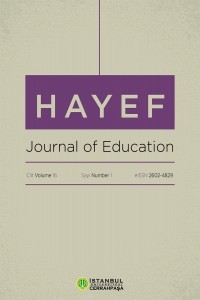3 Boyutlu Dijital Ortamda İngilizce Eğitimi
3 boyutlu, dijital, İngilizce eğitimi, sanal ortam, Second Life
English Language Education in a 3D Digital Environment
3D digital, English language, education, virtual environment, Second Life,
___
- Ahonen, A. K., & Kankaanranta, M. (2015). Introducing assessment tools for 21st century skills in Finland. In Patrick Griffin & Esther Care (Ed.), Assessment and teaching of 21st century skills: Methods and approach (pp. 213-225). Dordrecht, New York: Springer.
- Bastawrous, A., Hennig, B., & Livingstone, I. (2013). mHealth possibilities in a changing world. Distribution of global cell phone subscriptions. Journal of Mobile Technology in Medicine, 2(1), 22-25.
- Ishii, K. (2004). Internet use via mobile phone in Japan. Telecommunications Policy, 28(1), 43-58.
- Ito, M. (2005). Mobile phones, Japanese youth, and the re-placement of social contact. In Mobile Communications (pp. 131-148). London: Springer.
- Larson, L. C., & Miller, T. N. (2011). 21st century skills: Prepare students for the future. Kappa Delta Pi Record, 47(3), 121-123.
- Oksman, V., & Rautiainen, P. (2003). Perhaps it is a body part: How the mobile phone became an organic part of the everyday lives of Finnish children and teenagers. In James Everett (Ed.), Machines that become us: The social context of communication technology (pp. 293-308). New Brunswick: Transaction Publishers.
- Baykent, U. Ö. (2015). Philosophical investigations for a holistic approach to education: Towards the welfare of mankind. In I. Koleva, R. Efe, Z. Blagoeva Kostova, & E. Atasoy (Ed.), Education in the 21st century: theory and practice (pp. 524-535). Sofia, Bulgaria: St. Klimentski University Press.
- Baykent, U. Ö. (2016). Reading Aristotle’s Educatino for the 21st century. Advances in Social Sciences Research Journal, 3(12) 94-100.
- Prensky, M. (2001). Digital Natives, Digital Immigrants. On the Horizon, 9(5), 1-6.
- Rice, R. E., & Katz, J. E. (2003). Comparing internet and mobile phone usage: Digital divides of usage, adoption, and dropouts. Telecommunications Policy, 27(8), 597-623.
- Taylor, A. S., & Harper, R. (2002). Age-old practices in the 'new world': A study of gift-giving between teenage mobile phone users. Proceedings of the SIGCHI conference on Human factors in computing systems, 439-446.
- 21st century skills: Rethinking how students learn. (2010). J. Bellanca, R. Brandt (Ed.), Bloomington: Solution Tree Press.
- Trilling, B., & Fadel, C. (2009). 21st century skills: Learning for life in our times. Hoboken, NJ: John Wiley & Sons.
- Uzun, L. (2012a). The Internet and computer enhanced foreign language learning and intercultural communication. World Journal on Educational Technology, 4(2), 99-112.
- Uzun, L. (2012b). What is your educational philosophy? Modern and postmodern approaches to foreign language education. Studies in Second Language Learning and Teaching, 2(3), 333-348.
- Başlangıç: 2004
- Yayıncı: İstanbul Üniversitesi-Cerrahpaşa
Birey Yetiştirme Sürecinde Edebiyat Öğretiminin İşlevi: “Gülibik”, “Yaban” ve “İsa Bu Köye Uğramadı”
Çocuk Edebiyatında Toplumsal Cinsiyetsiz Karakterler: Bir Araştırma Örneği
Türkiye'de Suriyeli Öğrencilerin Eğitimine Yönelik Okul Yöneticilerinin Görüşleri
An Investigation into the Experiences of Erasmus Students
Öğretmenlerin Algılarına Göre İş Motivasyonu ve Örgütsel Özdeşleşme Arasındaki İlişki
